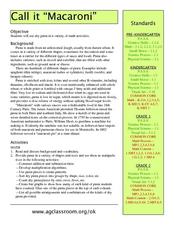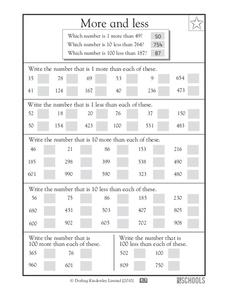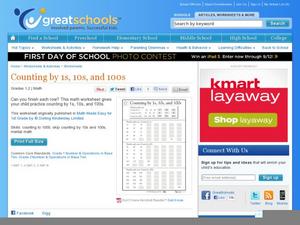Pennsylvania Department of Education
Playing with Patterns
Learners use objects and symbols to create original linear patterns. In this patterns lesson plan, students also translate patterns from one modality to another.
Curated OER
Finding Addition Patterns
Students practice finding the sums of two-one digit numbers. In this addition lesson plan, students also record facts onto an addition chart.
Curated OER
Hundred Number Chart
In this math worksheet, students examine a filled-in hundred number chart. Students discover number patterns and multiples while using this chart for any math purpose.
Curated OER
Pattern Play
Students create their own number patterns to reinforce their understanding of the concept of patterns. They also search for the unexpected guests in each other's patterns.
Curated OER
Call it "Macaroni"
Who knew there were so many fun educational opportunities featuring pasta? Scholars read a brief informational text about the history of pasta (note that "macaroni" is spelled two different ways, so address this if kids are reading...
Curated OER
Middle-East Reflections
Practice symmetry and patterns with this Mid-Eastern art project. Your class will create beautiful, reflective mosaics that will brighten up the classroom! A list of necessary materials is included.
Curated OER
Geo Jammin' By Design - Day 7, Lesson 38: Kool Cups
Create geometric cups by interpreting directions, informational text, and mathematical concepts. Critical thinkers apply geometric theory (congruent shapes, patterns, symmetry) to actual directions to create a cup that holds Kool Aid....
Curated OER
Frogs Hopping by 2s
Hop to it! Beginning counters fill in water lily number sequences as a frog "hops" across them, skip counting by twos. There are five sequences in total, and some require counting backward. Learners can reference the two examples, which...
Curated OER
Venn Diagrams, Part 3
Can your first graders interpret Venn diagrams? Different sets of clues help pupils narrow down a specific number in different shapes. They determine odds and evens, greater than or less than, and what shape the number is in. A fun...
Curated OER
Tiles, Blocks, Sapphires & Gold: Designing a Treasure Map
Young cartographers in groups hide treasure at school and then create a map to find it using pattern blocks and tiles. They make paintings with clues to create a visual representation of the location of their treasure. Groups present...
Curated OER
Counting by 3s, 4s, and 5s
Skip count along the mushrooms to complete these number sentences which give young scholars an introductory look at addition and subtraction. Starting from five double-digit numbers, they subtract or add by threes, fours, and fives to...
Curated OER
Counting Forward or Back
What comes next? Young counters follow the stone path to each house, filling in numbers in a sequence as they go. Some of these move forward and some backward, but all progress by ones. Learners start with given numbers and then follow...
Curated OER
Choose the Operation: Plus or minus (up to 100)
Investigate the relationship between addition and subtraction as scholars fill in these number sentences, each of which is missing a symbol. Is it a subtraction or addition equation? There are 20 of these to start, all written...
Curated OER
More and Less
Mental mathematicians add and subtract 1, 10, and 100 from sets of numbers. Each set of one, two and three-digit numbers gives scholars a chance to practice their addition and subtraction skills. There are 62 whole numbers in all. What...
Curated OER
Points on a Line
Get your learners up and moving, all while reviewing numbers on the number line! For this activity, learners are grouped in teams outdoors. The teacher will have already created number lines on the ground (with chalk, tape, etc.), and...
Curated OER
Hopping by 2s
Hop to it! Young counters practice skip counting by two using illustrations of animals hopping from place to place. Each image shows a number sequence and scholars draw in the path as they move from number to number. Encourage them to...
Maths Blog
Adding/Subtracting Whole Numbers in Your Head
Exercise those mental math muscles! This worksheet contains 10 addition and 10 subtraction problems which require learners to compute sums or differences in their heads. A quick review at the top of the page provides a strategy based on...
Curated OER
Counting by 1s, 10s, and 100s
These sequences are missing numbers and require some skip counting to complete. Scholars finish rows of numbers first counting by 1s, then 10s, and finally 100s. Each has three given numbers to get them started, and they fill in five...
Curated OER
Count By Two Worksheets
In these skip counting worksheets, students will complete the counting patterns by counting by 2's. For each number pattern, students must count by 2's a total of 8 consecutive times.
Curated OER
All A-buzz About Math
Second graders participate in Math-Eze activities to comprehend word problems. In this word problem instructional activity, 2nd graders recognize why a hexagon is the best shape for a beehive. Students calculate how far bees must travel...
Curated OER
Multiple Patterns
Second graders utilize a 1-100 grid to identify multiples of single digit numbers. They look for patterns and how they could be used to identify multiples to demonstrate the ability to use the multiplication facts and charts of single...
Curated OER
Repeating and Growing Patterns homework 6.5
For this continuing the pattern worksheet, students observe patterns, write the numbers, draw the next picture, and identify sequence as a repeating pattern or a growing pattern. Students write four answers.
Curated OER
Jelly Bean Math
Learners estimate, measure, compute, and create patterns using jelly beans. In small groups, they solve various calculations, place jelly beans into groups, invent a new flavor, create a pattern, and complete a worksheet.
Curated OER
Find a Pattern problem solving 6.6
In this finding a pattern using a table instructional activity, students write what they know and need to find out, make a table to show a pattern, and solve the pattern sequence. Students write nine answers.























